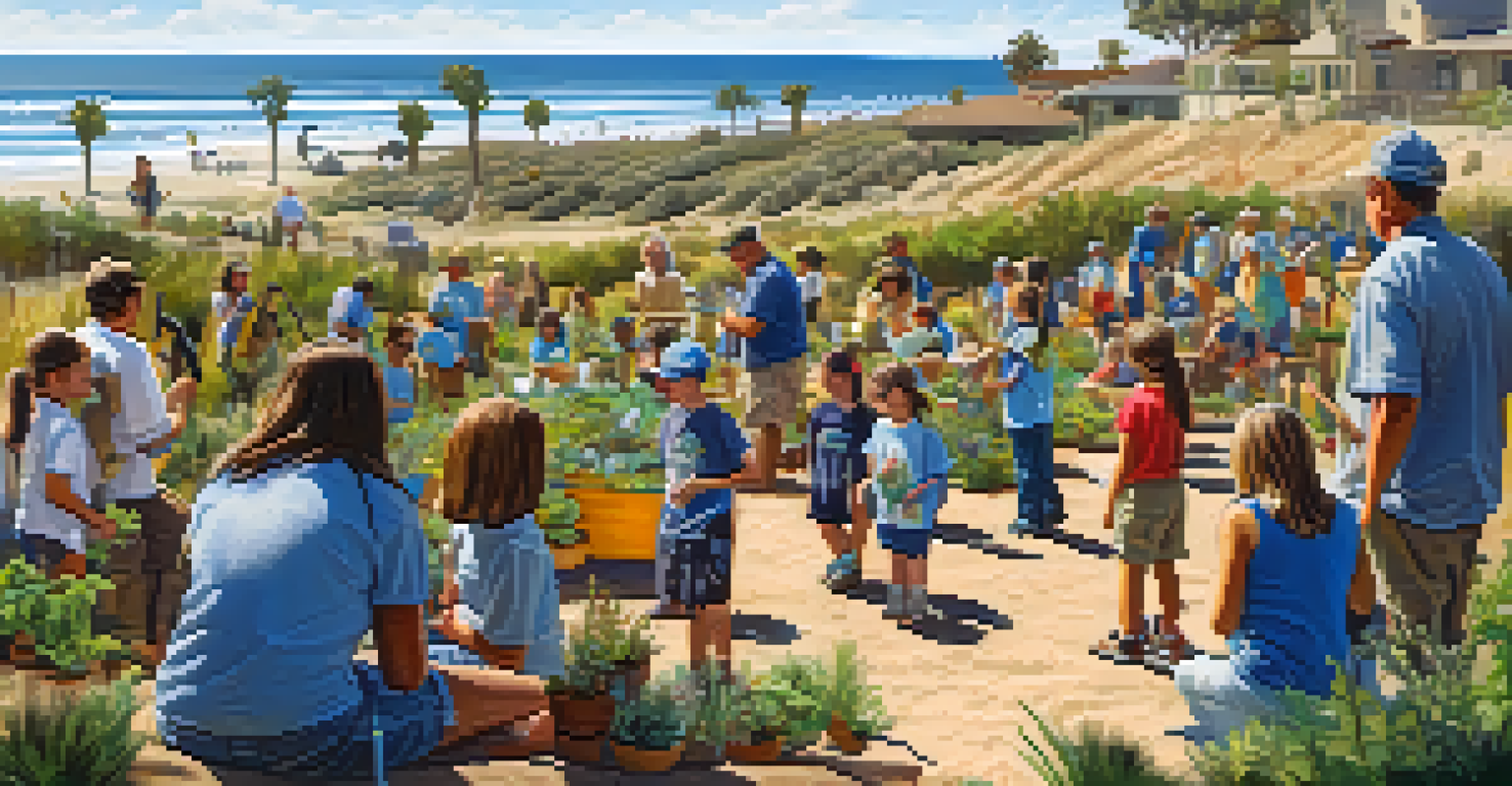Carlsbad's Commitment to Protecting Local Wildlife Habitats

Understanding Carlsbad's Unique Ecosystem
Carlsbad is home to a diverse range of ecosystems, from coastal wetlands to sprawling grasslands. These habitats host numerous species, some of which are endangered, making their protection vital. The city's unique geography creates a rich tapestry of wildlife that contributes to its ecological balance. By understanding the local ecosystems, residents can better appreciate the importance of preserving these natural areas.
The environment is where we all meet; where we all have a mutual interest; it is the one thing all of us share.
For example, the coastal areas of Carlsbad provide crucial nesting sites for endangered birds like the Western Snowy Plover. These birds rely on specific habitats to thrive, and even slight disturbances can jeopardize their populations. Additionally, the city’s native plant species play a role in supporting local wildlife, underscoring the interconnectedness of all living things in this environment. Recognizing these relationships is key to effective wildlife protection.
As Carlsbad continues to grow, balancing development with environmental stewardship is essential. This commitment to understanding and maintaining the ecosystem is a cornerstone of the city’s conservation efforts. By engaging with the community and fostering a sense of stewardship, Carlsbad aims to ensure that future generations can enjoy its natural beauty.
Local Initiatives for Wildlife Conservation
Carlsbad has implemented various initiatives aimed at conserving its local wildlife. Programs like habitat restoration and public education campaigns help raise awareness about the importance of protecting these areas. For instance, the city organizes volunteer days where residents can participate in planting native species and cleaning up natural habitats. These hands-on experiences foster a deeper connection between the community and their environment.

In addition to community involvement, Carlsbad has established partnerships with local organizations dedicated to wildlife conservation. These collaborations enhance resources and expertise, enabling more effective habitat protection strategies. For example, working with environmental nonprofits allows for the sharing of best practices and innovative conservation techniques. This teamwork amplifies the impact of their efforts.
Carlsbad's Diverse Ecosystems
Carlsbad's unique ecosystems, including coastal wetlands and grasslands, support a variety of wildlife, highlighting the need for conservation efforts.
Through these initiatives, Carlsbad demonstrates a comprehensive approach to wildlife conservation. The city not only focuses on protecting existing habitats but also seeks to restore degraded areas. By combining education, community action, and partnerships, Carlsbad sets a strong example for other cities looking to prioritize wildlife protection.
The Role of Community Education in Conservation
Education plays a pivotal role in Carlsbad's commitment to wildlife conservation. By empowering residents with knowledge about local ecosystems and species, the city fosters a culture of appreciation and stewardship. Programs in local schools and community centers teach the importance of biodiversity and the steps individuals can take to protect it. This grassroots approach ensures that conservation is a community-wide effort.
In every walk with nature, one receives far more than he seeks.
Workshops and events often feature local experts who share insights about wildlife and conservation practices. These sessions not only inform but also inspire community members to take action in their own lives. For example, learning about the benefits of native plants can encourage residents to incorporate them into their gardens, providing essential habitats for local wildlife. This ripple effect can significantly enhance the city’s ecological health.
Moreover, the city’s use of social media and online resources makes wildlife education accessible to everyone. Engaging content helps keep the community informed about ongoing conservation efforts and upcoming events. By fostering a well-informed public, Carlsbad creates a strong network of advocates for wildlife protection.
Land Use Planning and Wildlife Protection
Land use planning is critical in balancing urban development with wildlife protection in Carlsbad. The city prioritizes sustainable development practices that minimize disruption to natural habitats. By integrating conservation goals into the planning process, Carlsbad aims to preserve its unique ecosystems while accommodating growth. This forward-thinking approach is essential for maintaining biodiversity.
One example of this commitment is the establishment of green corridors in urban areas. These corridors provide safe passage for wildlife, allowing species to thrive despite urban development. Additionally, zoning regulations protect sensitive habitats from destructive practices. Such measures demonstrate that it is possible to harmonize growth with ecological preservation.
Community Engagement is Key
Through initiatives like volunteer days and educational programs, Carlsbad fosters community involvement in wildlife conservation.
By considering wildlife needs in land use decisions, Carlsbad sets an important precedent for other cities. This holistic approach ensures that development does not come at the expense of the environment. Ultimately, a well-planned city can support both human and wildlife populations.
Collaboration with Environmental Organizations
Carlsbad actively collaborates with various environmental organizations to enhance its wildlife protection efforts. These partnerships leverage expertise and resources, enabling more effective conservation projects. For instance, working with groups focused on endangered species allows the city to implement targeted strategies that address specific threats. This collaboration enriches the overall conservation landscape in Carlsbad.
Additionally, these organizations often assist in conducting research and monitoring wildlife populations. Such data is invaluable for making informed decisions about habitat management. By understanding the dynamics of local species, Carlsbad can tailor its conservation efforts to meet their needs. This synergy between the city and organizations fosters a comprehensive approach to wildlife protection.
Through these collaborations, Carlsbad not only enhances its conservation strategies but also builds a network of advocates. These organizations can mobilize volunteers and resources, amplifying the city’s impact. Together, they create a robust framework for preserving local wildlife.
Impact of Climate Change on Local Wildlife
Climate change presents significant challenges to wildlife habitats in Carlsbad. As temperatures rise and weather patterns shift, local ecosystems are under pressure. Species that once thrived in certain conditions may find it increasingly difficult to survive, leading to changes in biodiversity. Carlsbad recognizes these threats and is taking steps to mitigate climate change's impact on local wildlife.
One approach is to enhance habitat resilience by restoring native vegetation and improving water management practices. By creating environments that can withstand climate fluctuations, Carlsbad helps ensure the survival of local species. For example, planting drought-resistant plants can support wildlife even during dry spells. This proactive strategy demonstrates the city’s commitment to adapting to climate challenges.
Adapting to Climate Change
Carlsbad is proactively enhancing habitat resilience and raising awareness to mitigate the impacts of climate change on local wildlife.
Moreover, raising community awareness about climate change's effects fosters a shared responsibility for wildlife conservation. Engaging residents in discussions about sustainable practices encourages them to consider their ecological footprints. Together, these efforts can help safeguard Carlsbad’s rich wildlife heritage for future generations.
The Future of Wildlife Protection in Carlsbad
Looking ahead, Carlsbad is committed to evolving its wildlife protection strategies to meet emerging challenges. As urbanization continues and climate change accelerates, the city will need to adapt its approaches. Future initiatives may include expanding protected areas and enhancing community engagement efforts. By being forward-thinking, Carlsbad aims to stay ahead of potential threats to local wildlife.
Furthermore, the city plans to invest in research to better understand the impacts of environmental changes on local species. This data-driven approach will inform decision-making and help prioritize conservation actions. By remaining flexible and responsive, Carlsbad can effectively protect its unique wildlife habitats.

Ultimately, the future of wildlife protection in Carlsbad lies in collaboration and innovation. By bringing together community members, organizations, and experts, the city can create a robust framework for preserving its natural heritage. Through ongoing commitment and action, Carlsbad will continue to be a leader in wildlife conservation.